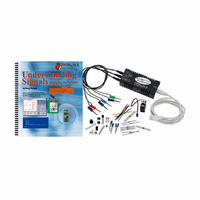28119 Parallax Inc, 28119 Datasheet - Page 107

28119
Manufacturer Part Number
28119
Description
KIT UNDERSTANDING SIGNALS
Manufacturer
Parallax Inc
Datasheet
1.28119.pdf
(137 pages)
Specifications of 28119
Lead Free Status
Contains lead
Accessory Type
Oscilloscope
Interface Type
USB
For Use With/related Products
BASIC Stamp® 2 and Board of Education
Lead Free Status / Rohs Status
Lead free / RoHS Compliant
Available stocks
Company
Part Number
Manufacturer
Quantity
Price
Company:
Part Number:
281197-2
Manufacturer:
TE
Quantity:
20 000
Company:
Part Number:
281197-2
Manufacturer:
MOLEX
Quantity:
2 500
- Current page: 107 of 137
- Download datasheet (5Mb)
Chapter 8: Operational Amplifiers
many types of amplifiers, each with different characteristics. This chapter will introduce
you to simple signal conditioning with an operational amplifier, commonly called an op-
amp (Figure 8-1). Op-amps have many, many potential functions in a wide variety of
applications, but our introduction will be limited to a few common examples.
OP-AMPS AND THEIR USES AND LIMITATIONS
The op-amp is a very easy to use voltage amplifier. It accepts a voltage as an input and
produces a mathematically related voltage on its output. Resistors can be used to
configure the mathematical function that dictates the related output. By using a formula
to select the input resistor (Ri) and the feedback resistor (Rf), you can set the gain of the
op-amp. The gain is a numeric multiplier that refers to the relative difference between
the voltage of the input signal and the voltage of the output signal. Therefore, once you
know the gain of a given op-amp circuit, you can multiply the input voltage by the gain to
get the output voltage. For example, an op-amp with a gain of 2 will have an output
voltage twice the input voltage.
There are limits to the op-amp that need to be considered before proceeding. The main
limiting factors are:
Supply Voltage
Supply voltage and output range are related. An op-amp cannot create output signals any
larger than the voltage applied at the Vcc and Vee pins. This output voltage (or range) is
called the dynamic range of the op-amp. Some op-amps can have a dynamic range as
large as the span of the voltage supplied; they are called rail-to-rail op-amps. For
Amplifiers are used in everything from car stereos to medical equipment. There are
•
•
Supply voltage and output range
Slew rate
Non-inverting
Inverting
Input
Input
Vcc
Vee
Output
Figure 8-1:
Op-amp schematic
symbol
Related parts for 28119
Image
Part Number
Description
Manufacturer
Datasheet
Request
R

Part Number:
Description:
Microcontroller Modules & Accessories DISCONTINUED BY PARALLAX
Manufacturer:
Parallax Inc

Part Number:
Description:
BOOK UNDERSTANDING SIGNALS
Manufacturer:
Parallax Inc
Datasheet:

Part Number:
Description:
COMPETITION RING FOR SUMOBOT
Manufacturer:
Parallax Inc
Datasheet:

Part Number:
Description:
TEXT INFRARED REMOTE FOR BOE-BOT
Manufacturer:
Parallax Inc
Datasheet:

Part Number:
Description:
BOARD EXPERIMENT+LCD NX-1000
Manufacturer:
Parallax Inc
Datasheet:

Part Number:
Description:
CONTROLLER 16SERVO MOTOR CONTROL
Manufacturer:
Parallax Inc
Datasheet:

Part Number:
Description:
BASIC STAMP LOGIC ANALYZER
Manufacturer:
Parallax Inc
Datasheet:

Part Number:
Description:
IC MCU 2K FLASH 50MHZ SO-18
Manufacturer:
Parallax Inc
Datasheet:















